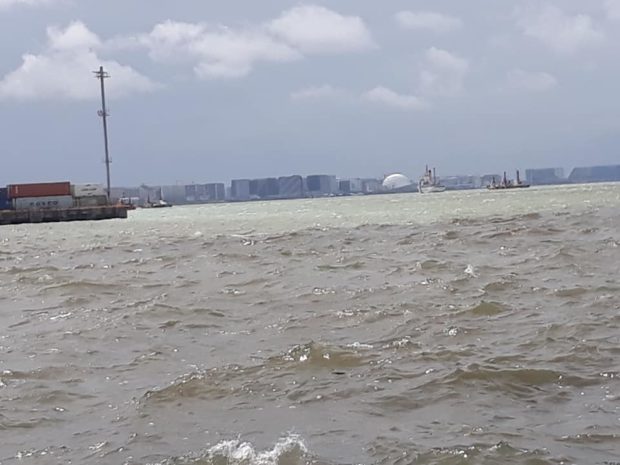
Contributed photo by Ghine Nequia
MANILA, Philippines — The Department of Environment and Natural Resources (DENR) believes that the claims of fish kill and waters becoming murky white in the Baseco portion of the Manila Bay were not caused by the crushed dolomite dumped near the Baywalk area.
DENR Undersecretary Benny Antiporda insisted on Thursday that it is “very erroneous” to outrightly assert that the dolomite sand was responsible for the death of marine life in the area, as well as allegations of the sand mixing with water.
While Antiporda assured that they would look into the matter and send out drones on Friday to check the situation, he said that DENR personnel who went to Baseco Compound did not see the fish kill.
“What I can say is as of now, these claims are doubtful, quick assumptions that the fish kill was brought by the nourishment is erroneous. Because if that happened due to the nourishment area, would you imagine, the dead fishes should have washed up at the pier, near the Manila Baywalk area, and not in Baseco,” Antiporda said in Filipino.
“That’s our view, immediately saying that dolomite caused the issue is very erroneous. Now, for the satisfaction of everybody, we will fly drones over the area tomorrow to see their claims,” he added.
Instead, Antiporda, who visited Manila Bay in the morning when the report came out, noted that the fishes near Manila Bay were mostly tilapia — a fresh water fish that should have not moved to the salt waters of the bay area.
“When I was at Manila Bay earlier, the fishes I saw there were tilapia. I was confused why I saw one there when the water is salty, it may not be able to live there. A while ago we had people in Baseco, they did not see anything like that which prompted us to investigate what fish was that, how, when, and why it happened,” he assured.
Earlier, photos of Manila Bay waters near the Baseco Compound surfaced on social media showing waters ranging from a light gradient of brown to flesh colors, while fish seen floating ashore. This occurred after monsoon rains swept through Metro Manila and its neighboring provinces.
In the photos, a lot of netizens claimed that changes in Manila Bay’s water may have been caused by the crushed dolomite, which was placed at the Baywalk area alongside Roxas Boulevard to beautify the tourist spot.
However, members of the group Pambansang Lakas ng Kilusang Mamamalakaya ng Pilipinas (Pamalakaya) and other environment organizations and individuals noted the harmful effects of dolomite on human beings and on the ecosystem, citing United States studies about crushed dolomite being a causative agent for cancer.
Still, Antiporda claimed that it is almost impossible for the dolomite sand to reach Baseco and for the fish kill to be concentrated only in that area when the prevailing southwest monsoon brings wind from the southwestern side up towards the northeastern side. He also cited the long proximity and the two break waters that separate the dolomite overlaying project site to the Baseco area.
In that scenario, Antiporda believes dead fishes should have washed ashore the baywalk area too.
“The distance between the nourishment and Baseco is just five kilometers away, so it is impossible that the fishes ended up there and none here. That is not due to the dolomite. They immediately made that angle, other reporters, that is what they placed but here is our explanation,” he noted.
“So we’re looking at the situation that it might be possible that it was the same as last year, a fish kill happened last October 10, maybe this year it was earlier. That’s what we’re looking at,” he added.
As of now, the posts on the alleged murky white water and fish kill have been picked up by various groups and news agencies to raise questions, whether this was caused by the dolomite dumping issue — a project that costs around P349 million.